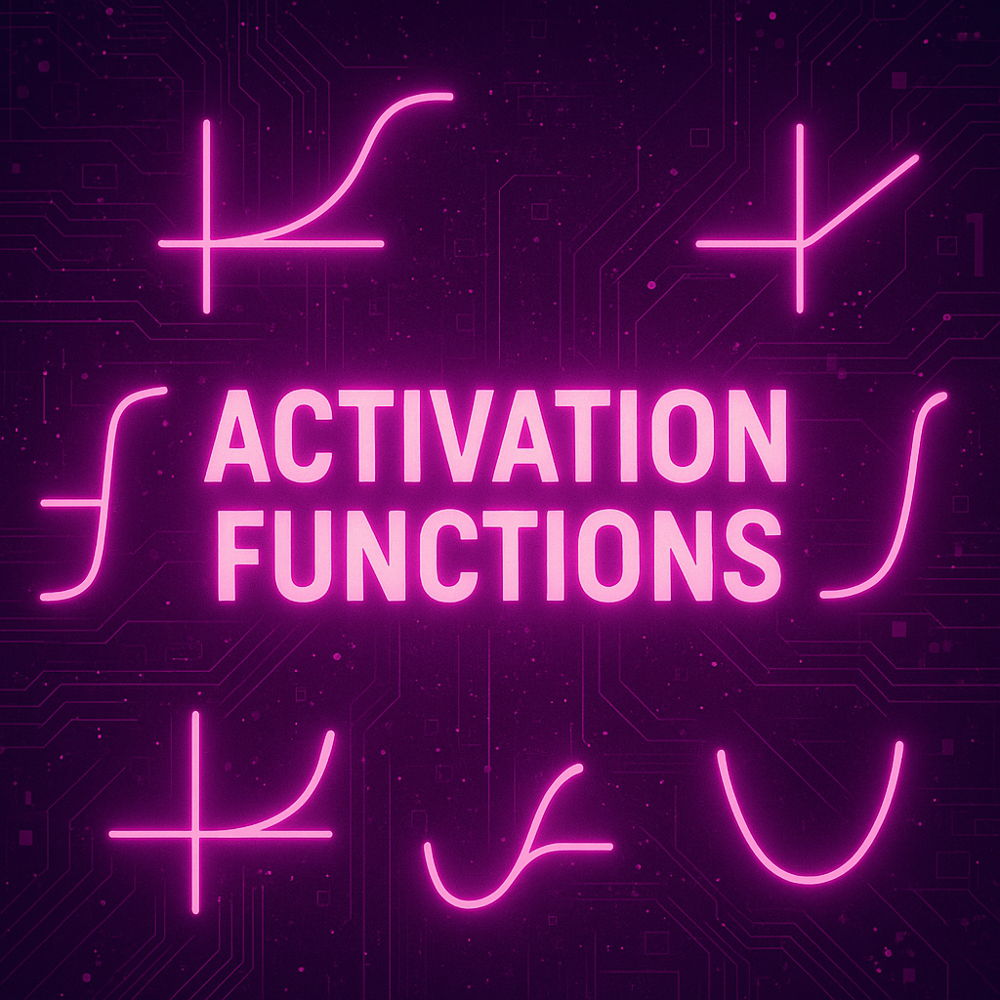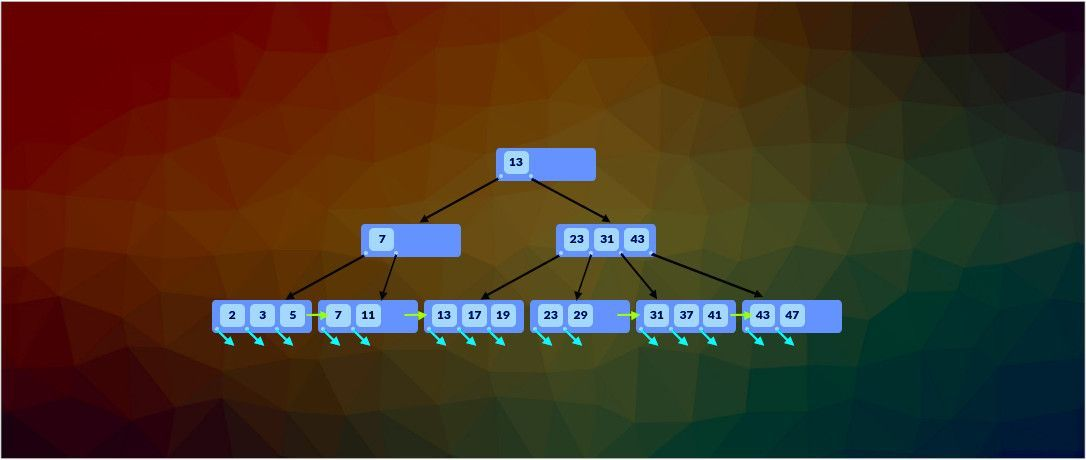Activation Functions in Machine Learning
We study various activation functions, their characteristics, and their impact on the performance of machine learning models.

Daniel Gustaw
• 14 min read

Activation functions are at the heart of every neural network, determining how signals propagate and interact through layers. In this post, we’ll explore and compare several popular activation functions using a minimal neural network on a toy dataset.
We’ll focus on how quickly each function helps the network converge—and how well it performs in a binary classification task with a nonlinear decision boundary.
Problem Setup
We simulate a simple 2D classification task:
- We generate
1000random2Dpoints from a Gaussian distribution. - We label each point as
1if it lies inside the unit circle, and0otherwise.
This creates a nonlinearly separable dataset, perfect for testing activation functions.
import torch
import numpy as np
N = 1000
x = torch.randn(N, 2) * (1 / np.sqrt(2 * np.log(2)))
y = ((x[:, 0]**2 + x[:, 1]**2) < 1).float().unsqueeze(1)
The coefficient ensures that half of the points lie inside the unit circle and half outside:
We want to compute the probability:
This is equivalent to computing:
Switching to polar coordinates:
Separate the integrals:
The remaining part:
Let’s compute this integral using substitution , so:
So the final result is:
Now, solve for such that this probability equals :
Model Architecture
We use a small feedforward neural network with the following structure:
-
Input layer: 2 neurons (for 2D data)
-
Hidden layers: [16, 8] neurons
-
Output: 1 neuron for binary classification (with
BCEWithLogitsLoss)
Each hidden layer is followed by an activation function that we want to test.
import torch.nn as nn
def build_model(activation, layers=[2, 16, 8, 1]):
layers_out = []
for i in range(len(layers) - 2):
layers_out += [nn.Linear(layers[i], layers[i+1]), activation()]
layers_out += [nn.Linear(layers[-2], layers[-1])]
return nn.Sequential(*layers_out)
Training and measurement
To train the model we need to select loss function, optimizer and number of steps. We can wrap it in function that return series of learning time and loss that will be useful to visualize performance of actiation functions.
We can select training properties:
- Loss function:
BCEWithLogitsLoss(numerically stable for binary classification) - Optimizer: Adam with learning rate
0.01 - Epochs: 2000 steps
- We record loss vs. time to see which activations converge fastest.
import torch.optim as optim
import time
# Training loop with timing
def train_timed(model, name, lr=0.01, steps=2000):
loss_fn = nn.BCEWithLogitsLoss()
optimizer = optim.Adam(model.parameters(), lr=lr)
losses = []
times = []
start_time = time.time()
for step in range(steps):
pred = model(x)
loss = loss_fn(pred, y)
optimizer.zero_grad()
loss.backward()
optimizer.step()
elapsed = time.time() - start_time
losses.append(loss.item())
times.append(elapsed)
return times, losses
We decided to use Adam optimizer that is often chosen because it combines the strengths of two popular optimizers: AdaGrad and RMSProp and works well out-of-the-box for many problems.
To train model we can call train_timed function with our model and some parameters.
model = build_model(nn.ReLU)
t, l = train_timed(model, 'ReLU')
Our goal is to compare different activation functions, but now, lets see how model predict shape using training points.
Model prediction visualization
Let’s plot model prediction using code
import numpy as np
import matplotlib.pyplot as plt
from matplotlib.patches import Circle
import torch
# 1. Generate grid
xs = np.arange(-2, 2.1, 0.2)
ys = np.arange(-2, 2.1, 0.2)
xx, yy = np.meshgrid(xs, ys)
Xmesh = np.c_[xx.ravel(), yy.ravel()]
inputs = torch.tensor(Xmesh).float()
# 2. Predict
with torch.no_grad():
scores = torch.sigmoid(model(inputs)).squeeze().numpy()
Z = (scores > 0.5).reshape(xx.shape)
# 3. Plot
plt.style.use('dark_background')
fig, ax = plt.subplots(figsize=(8, 8))
# Green-black binary decision surface
ax.contourf(xx, yy, Z, levels=1, colors=["black", "#00FF00"], alpha=0.25)
# Data points: class 1 = bright green, class 0 = dim green
colors = ['#BB3300', '#00FF00']
point_colors = [colors[int(label)] for label in y.squeeze().tolist()]
ax.scatter(x[:, 0], x[:, 1], c=point_colors, s=20, edgecolors='none')
# Circle border
circle = Circle((0, 0), 1, color="#00FF00", fill=False, linewidth=1.5)
ax.add_patch(circle)
# Cleanup for hacker aesthetic
ax.set_xlim(xx.min(), xx.max())
ax.set_ylim(yy.min(), yy.max())
ax.set_xticks([])
ax.set_yticks([])
ax.set_facecolor('black')
ax.spines['top'].set_visible(False)
ax.spines['bottom'].set_visible(False)
ax.spines['left'].set_visible(False)
ax.spines['right'].set_visible(False)
plt.tight_layout()
plt.show()
Let’s compare activation functions
We compare the following activation functions:
| Name | Description |
|---|---|
ReLU | Fast and effective, but can “die” on negative inputs (zero gradient). |
Tanh | Smooth, zero-centered, but saturates for large values (vanishing gradients). |
LeakyReLU | ReLU variant allowing a small gradient when inputs are negative. |
Sigmoid | Outputs between 0 and 1; suffers from vanishing gradients. |
ELU | Like ReLU but smoother and can output negatives, improving learning. |
SiLU | Also known as Swish; smooth and non-monotonic; promotes better generalization. |
GELU | Gaussian-based; smooth and probabilistic, popular in Transformers. |
Softplus | Smooth approximation of ReLU; always differentiable but more expensive. |
We can compare these graphs by code that will create grid of activation functions.
import torch
import torch.nn as nn
import matplotlib.pyplot as plt
import numpy as np
# Define input range
x = torch.linspace(-3, 3, 1000)
# Activation functions with display names
activations = [
("ReLU", nn.ReLU()),
("Tanh", nn.Tanh()),
("LeakyReLU", nn.LeakyReLU()),
("Sigmoid", nn.Sigmoid()),
("ELU", nn.ELU()),
("SiLU", nn.SiLU()),
("GELU", nn.GELU()),
("Softplus", nn.Softplus())
]
x_ticks = np.arange(-2, 3, 1)
y_ticks = np.arange(-2, 3, 1)
# Create subplot grid
fig, axes = plt.subplots(2, 4, figsize=(14, 6), sharex=True, sharey=True)
axes = axes.flatten()
for ax, (name, fn) in zip(axes, activations):
y = fn(x)
ax.plot(x.numpy(), y.detach().numpy(), label=name, color="tab:blue")
ax.axhline(0, color='gray', lw=0.5)
ax.axvline(0, color='gray', lw=0.5)
ax.set_title(name)
ax.grid(True, linestyle='--', linewidth=0.5)
ax.legend(frameon=False, loc="lower right", fontsize='small')
ax.tick_params(axis='both', which='both', labelsize=8) # Ensure ticks show
ax.set_xticks(x_ticks)
ax.set_yticks(y_ticks)
ax.ticklabel_format(style='sci', scilimits=(-2, 2), axis='both')
# Add main title and layout
fig.suptitle("Activation Functions", fontsize=16)
fig.tight_layout(rect=[0, 0, 1, 0.95])
# Save as vector image
plt.savefig("activations_grid.svg", format="svg", dpi=300)
plt.show()
Single training is not enough
Naive approach is to just train every model with given activation function and compare results:
import matplotlib.pyplot as plt
# Configs to compare
configs = [
("ReLU", nn.ReLU), # Rectified Linear Unit: fast and simple, but can "die" (zero gradient for x < 0)
("Tanh", nn.Tanh), # Hyperbolic tangent: zero-centered, but saturates at extremes
("LeakyReLU", nn.LeakyReLU), # Variant of ReLU: allows small gradient when x < 0 to prevent dead neurons
("Sigmoid", nn.Sigmoid), # Maps input to (0, 1): good for probabilities, but suffers from vanishing gradients
("ELU", nn.ELU), # Exponential Linear Unit: smooth ReLU alternative, can produce negative outputs
("SiLU", nn.SiLU), # Sigmoid-weighted Linear Unit (Swish): smooth and non-monotonic, helps generalization
("GELU", nn.GELU), # Gaussian Error Linear Unit: used in Transformers, smooth and noise-tolerant
("Softplus", nn.Softplus) # Smooth approximation of ReLU: always positive gradient, but computationally heavier
]
# Train and collect
results = []
for name, act_fn in configs:
print(f"Training {name}...")
model = build_model(act_fn)
t, l = train_timed(model, name)
results.append((name, t, l))
# Plotting
plt.figure(figsize=(10, 6))
plt.yscale('log')
for name, times, losses in results:
plt.plot(times, losses, label=name)
plt.xlabel("Time (s)")
plt.ylabel("Loss")
plt.title("Convergence over Time")
plt.legend()
plt.grid(True)
plt.tight_layout()
plt.savefig("activation_8_2000_5.svg", format="svg", dpi=300)
plt.show()
Although we can see huge advantage of LeakyReLU in first run:
Calling the same code second time we can see that results are different:
Especially that GELU performance is much better. It means that to really compare these functions we need run these simulations many times, but before it, I would like to show you what can happen when we will train little longer time.
There you can see that initially slower Tanh was more stable in long time run, but LeakyReLU failed completely. I present these graphs, but you have to be aware that these are just single learning results and to construct any valuable conclusions we have to run them many times.
But we see that single run give us dynamics of learning that can’t be cut in any single arbitral selected point, because of position on ranking can change in dependence from training duration.
So due this reason we will save to database all measured losses in objects like this:
{
"name": "ReLU",
"time": 1.54,
"loss": 0.02,
"epoch": 2000
}
So in next paragraph we will add saving results to database and run simulations many times.
Running multiple simulations
Let’s add steps array to output of train_timed function.
def train_timed(model, name, lr=0.01, steps=2000):
loss_fn = nn.BCEWithLogitsLoss()
optimizer = optim.Adam(model.parameters(), lr=lr)
losses = []
times = []
_steps = []
start_time = time.time()
for step in range(steps):
pred = model(x)
loss = loss_fn(pred, y)
optimizer.zero_grad()
loss.backward()
optimizer.step()
elapsed = time.time() - start_time
losses.append(loss.item())
times.append(elapsed)
_steps.append(step)
return times, losses, _steps
Then we can build wrapper that saves results to MongoDB database and allow for multiple runs:
def train_n_times(n=1, lr=0.01, steps=2000):
client = MongoClient("mongodb://localhost:27017/")
db = client["experiment_db"]
collection = db["activations"]
for name, act_fn in configs:
times, losses, epochs = [], [], []
for _ in range(n):
model = build_model(act_fn)
time_taken_list, loss_list, epoch_list = train_timed(model, name, lr, steps)
times.extend(time_taken_list)
losses.extend(loss_list)
epochs.extend(epoch_list)
documents = [
{"name": name, "time": t, "loss": l, "epoch": e}
for t, l, e in zip(times, losses, epochs)
]
collection.insert_many(documents)
client.close()
return 0
and finally call train_n_times function to run the training for all activation functions multiple times.
train_n_times(1000, 0.01, 2000)
Analysis of results (by epoch)
Now lets extract results form mongo database and plot them.
To simplify we can use epochs as x-axis instead of time. First part of code gets data and organize them in DataFrame for each activation function.
from pymongo import MongoClient
import pandas as pd
# Define activation functions
activation_names = [
"ReLU", "Tanh", "LeakyReLU", "Sigmoid",
"ELU", "SiLU", "GELU", "Softplus"
]
# Connect to MongoDB
client = MongoClient("mongodb://localhost:27017/")
db = client["experiment_db"]
collection = db["activations"]
# Dictionary to store DataFrames per activation
summaries = {}
for name in activation_names:
cursor = collection.find(
{"name": name},
{"_id": 0, "epoch": 1, "loss": 1}
)
df = pd.DataFrame(list(cursor))
if df.empty:
continue
summary = df.groupby("epoch")["loss"].agg(["mean", "std", "count"]).reset_index()
summaries[name] = summary
Second part is responsible for plotting.
import matplotlib.pyplot as plt
import numpy as np
# Setup plot
plt.figure(figsize=(12, 8))
plt.yscale('log')
for name, summary in summaries.items():
x = summary["epoch"].to_numpy()
means = summary["mean"].to_numpy()
count = summary["count"].to_numpy()
errors = summary["std"].to_numpy() / np.sqrt(count)
lower = np.clip(means - errors, a_min=1e-10, a_max=None)
upper = means + errors
plt.plot(x, means, label=name)
plt.fill_between(x, lower, upper, alpha=0.2)
plt.xlabel("Epoch")
plt.ylabel("Loss (log scale)")
plt.title("Learning Curves by Activation Function")
plt.legend()
plt.grid(True, which="both", ls="--", linewidth=0.5)
plt.tight_layout()
plt.savefig("activation_1000_calls.svg", format="svg", dpi=300)
plt.show()
We can check loss for last epoch for each activation function:
results = []
for name, summary in summaries.items():
mean = summary["mean"].to_numpy()[-1]
stderr = summary["std"].to_numpy()[-1] / np.sqrt(summary["count"].to_numpy()[-1])
results.append((name, mean, stderr))
# Sort by mean
results.sort(key=lambda x: x[1]) # x[1] is the mean
# Print sorted results
for name, mean, stderr in results:
print("%-9s : %6.6f ± %6.6f" % (name, mean, stderr))
Results:
LeakyReLU : 0.000170 ± 0.000007
GELU : 0.000220 ± 0.000003
ELU : 0.000229 ± 0.000002
SiLU : 0.000303 ± 0.000003
Tanh : 0.000396 ± 0.000003
ReLU : 0.000433 ± 0.000021
Softplus : 0.001038 ± 0.000099
Sigmoid : 0.002588 ± 0.000569
Analysis by time
To plot learning curves by time we need to convert float time measurements to bins with fixed size.
from pymongo import MongoClient
import pandas as pd
# Define activation functions
activation_names = [
"ReLU", "Tanh", "LeakyReLU", "Sigmoid",
"ELU", "SiLU", "GELU", "Softplus"
]
# Connect to MongoDB
client = MongoClient("mongodb://localhost:27017/")
db = client["experiment_db"]
collection = db["activations"]
# Dictionary to store DataFrames per activation
summaries = {}
for name in activation_names:
cursor = collection.find(
{"name": name},
{"_id": 0, "time": 1, "loss": 1}
)
df = pd.DataFrame(list(cursor))
if df.empty:
continue
bin_size = 0.01 # 10ms resolution
df["time_bin"] = (df["time"] // bin_size) * bin_size
df["time_bin"] = df["time_bin"].round(3)
summary = df.groupby("time_bin")["loss"].agg(["mean", "std", "count"]).reset_index()
summary.rename(columns={"time_bin": "time"}, inplace=True)
summaries[name] = summary
Thanks to this technique we can plot learning curves by time.
import matplotlib.pyplot as plt
import numpy as np
# Setup plot
plt.figure(figsize=(12, 8))
plt.yscale('log')
for name, summary in summaries.items():
x = summary["time"].to_numpy()
means = summary["mean"].to_numpy()
count = summary["count"].to_numpy()
errors = 20 * summary["std"].to_numpy() / np.sqrt(count)
lower = np.clip(means - errors, a_min=1e-10, a_max=None)
upper = means + errors
plt.plot(x, means, label=name)
plt.fill_between(x, lower, upper, alpha=0.2)
plt.xlabel("Second")
plt.ylabel("Loss (log scale)")
plt.title("Learning Curves by Activation Function")
plt.legend()
plt.grid(True, which="both", ls="--", linewidth=0.5)
plt.xlim(left=0, right=0.7)
plt.ylim(1e-4, 1)
plt.tight_layout()
plt.savefig("activation_1000_calls_sec.svg", format="svg", dpi=300)
plt.show()
Conclusions
It is worth to compare our results with paper that contain much more benchmarks summary Activation Functions in Deep Learning: A Comprehensive Survey and Benchmark.
Although in my benchmark LeakyReLU is the best, in paper they found that it depends on use case, dataset and network complexity. I will sum up this paper conclusions and compare them with our results.
1. There’s No Universal Winner
No single activation function dominates across all datasets and models.
Some functions (like Swish and Mish) perform consistently well, but aren’t always the best in every scenario.
Choose AFs based on your model and dataset — not blindly.
2. ReLU Is Still Strong
Despite being old and simple, ReLU remains competitive across many tasks.
It performs especially well in deeper networks (like CNNs) and large datasets.
Start with ReLU. It’s a strong default.
3. Swish, Mish, and GELU Stand Out
These are smooth, nonlinear, and adaptive functions.
They outperform ReLU on certain tasks — especially on more complex datasets or deeper networks.
-
Swish:
-
Mish:
-
GELU: Gaussian Error Linear Unit
Try these when training accuracy stalls or gradients vanish.
4. Leaky/Parametric ReLU Help for Sparse Gradients
Variants like Leaky ReLU and PReLU solve ReLU’s “dying neuron” problem.
Especially useful in smaller datasets where neurons can go inactive.
Use these when parts of your network go silent.
5. Sigmoid/Tanh Perform Poorly in Deep Networks
They cause vanishing gradients and saturate easily.
In deep models, they tend to slow down training and hurt performance.
Avoid sigmoid/tanh unless you’re in shallow or legacy models (e.g. old RNNs).
6. Computational Cost Matters
Fancy activations like Mish and GELU are heavier to compute than ReLU.
On mobile or edge devices, ReLU may be preferable for speed and efficiency.
Balance performance and compute cost based on your deployment target.
So in our situation we actually can confirm bad results of tanh and sigmoid. Winners:
- LeakyReLU
- GELU
- ELU
- SiLU
are just modification of ReLU that are recommended as remedy for “dying neurons” problem or for small datasets.
It seems that be our case because 1000 points can be considered as small, so smoother versions of ReLU are actually better in this case what confirm results from analysed publication.
Good practice seems to be starting with ReLU and trying other functions later if we have enough time for training and experiments.
Other articles
You can find interesting also.

Login by Metamask - Rest Backend in Fastify (Node, Typescript, Prisma)
We building from scratch rest api in fastify using mongodb connected by prisma as database, jest as test framework and etherjs to verify signatures signed by metamask.

Daniel Gustaw
• 21 min read

We squeeze data from PDF like juice from a lemon
In this post, we will show how to conveniently extract data from PDF files by writing really minimal amounts of code.

Daniel Gustaw
• 7 min read

The impact of indexing on search performance in MySQL database
Using indexes speeds up searches and increases table size while slowing down modifications. The article shows how to profile queries and measure the impact of indexes on search performance.

Daniel Gustaw
• 15 min read